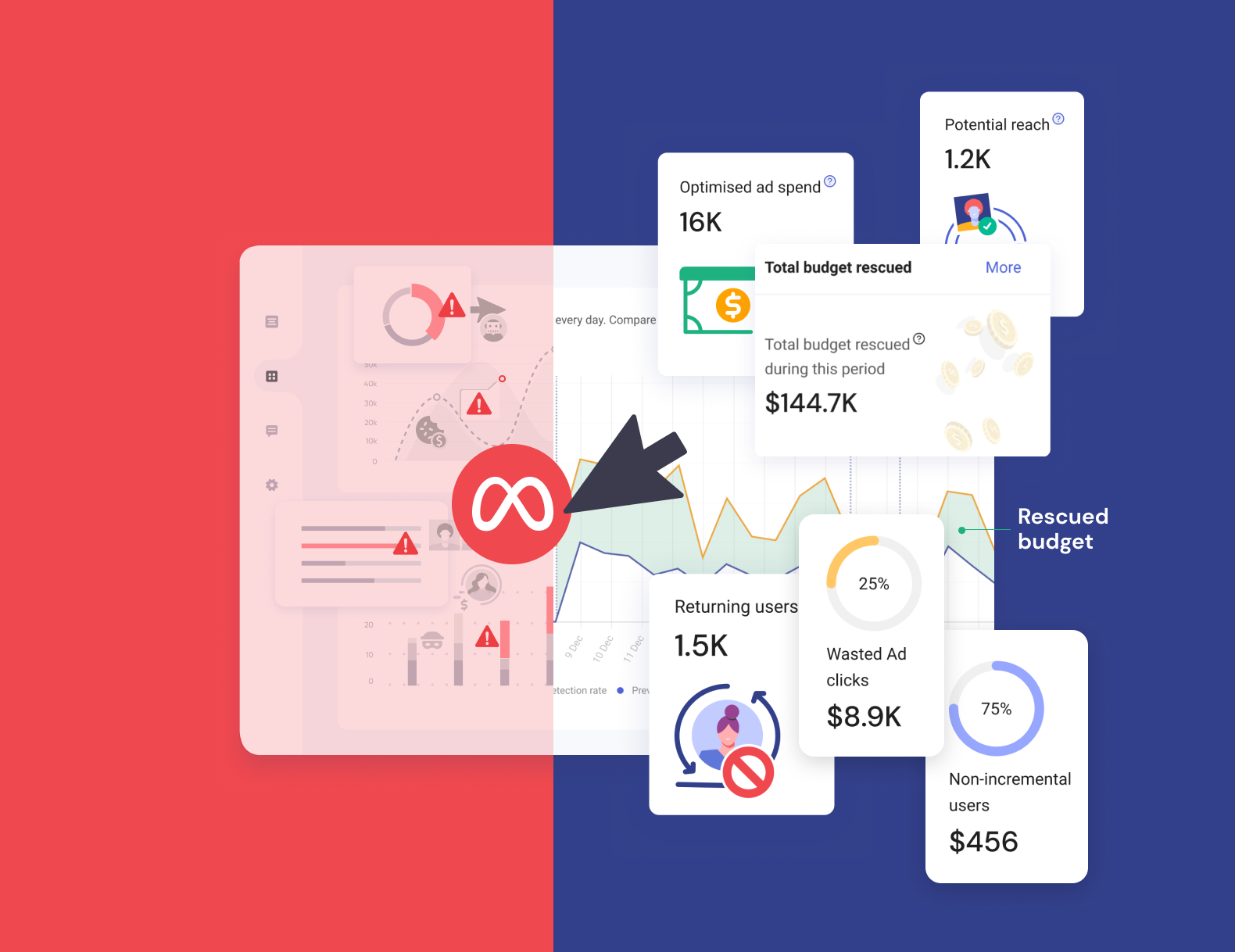Five Signs of Ad Fraud in your Digital Marketing Campaigns

Do you ever look at the results of your Google Ads campaigns and find yourself scratching your head at what they are showing you? Take comfort in knowing you are not alone.
Even the most experienced marketers can feel baffled trying to understand why impressions that look promising fail to convert, or why traffic spikes without reason. Digital ad fraud can lead to misleading impressions, wasted budget, and distorted data that make it difficult to measure genuine performance.
Marketing data blindness is a serious condition, and it can have grim symptoms: poorly optimised ad spend, wasted budget, and a lack of actionable insights.
Very often, ad fraud is the cause, and it can wreak havoc on your campaigns in plain sight.
These five warning signs are your go-to checklist for spotting fraudulent activity. If any look familiar, it may be time to take action.
What Is Ad Fraud, the Types of Ad Fraud, and Why Should You Care?
Ad fraud is the deliberate manipulation of digital advertising metrics to generate fraudulent revenue. It occurs when bad actors exploit ad systems to fake clicks, impressions, or conversions, diverting your ad spend away from genuine audiences.
Common forms of ad fraud include:
- Ad stacking – multiple ads layered on top of each other, counting impressions for all even though only the top one is visible.
- Click farms – groups of low-paid workers manually clicking on ads.
- Cookie stuffing – adding multiple cookies to a user’s browser to claim affiliate commissions. Watch our short video explaining cookie stuffing to see how this tactic works in practice.
The impact? Wasted budget, skewed performance data, and weakened ROI. Fraudsters take advantage of high advertising budgets, diverting spend towards fake engagements instead of real customers.
Financial losses are only part of the problem because polluted data makes campaign optimisation nearly impossible. To stay protected, brands need to implement multi-layered ad fraud prevention strategies and reliable click fraud detection software.
Five Warning Signs of Ad Fraud in Your Campaigns
1. Suspicious Traffic Sources
A sudden influx of traffic from low-quality websites or strange IP addresses is a major red flag. This traffic often comes from bots or click farms rather than genuine users. Always vet your ad networks carefully to ensure traffic quality.
2. Unusual Click Patterns
Patterns such as a surge of clicks at the same time every day or spikes from unexpected locations can indicate click fraud. Mobile ad fraud tactics, including click injection or click spamming, also create these irregularities.
3. High Click-Through Rates (CTR)
A high CTR can look like a win, but if post-click engagement is poor, it is likely the result of automated bots generating fake interactions. Always compare CTR against downstream metrics such as conversion and session duration to uncover discrepancies.
4. High Bounce Rates
Fraudulent clicks often result in users immediately leaving your site, causing inflated bounce rates. This is a clear sign that the clicks were not from genuine, interested visitors.
5. Abnormally High Impressions
An unusually large number of impressions without corresponding engagement may be due to impression fraud. Tactics such as ad stacking or hidden placements inflate numbers, misleading advertisers into thinking their ads are performing better than they are.
What to Do if You Detect Ad Fraud
If any of these warning signs look familiar, it is time to act. Here is how to take control:
- Use ad fraud detection tools – implement software that analyses and blocks invalid traffic in real time.
- Monitor traffic sources – review IP logs and referral URLs regularly to spot anomalies.
- Analyse click patterns – identify patterns of suspicious activity or abnormally high click counts.
- Review metrics frequently – track CTR, bounce rate, and impressions to detect irregular performance trends.
Implementing fraud detection and prevention tools will help protect your ad budget and ensure data integrity. With cleaner traffic, your campaigns perform better, conversion tracking becomes more accurate, and every pound spent contributes to genuine growth.
If you are managing campaigns across Google Ads, explore TrafficGuard for Search to stop invalid clicks in real time and keep your campaigns optimised for real users.
Success Story
One of our sports betting customers noticed a surge in bonus redemptions but very few conversions following their campaign. On closer inspection, invalid traffic was to blame.
By identifying the warning signs early and partnering with TrafficGuard, they regained control of their campaign performance and redirected budget towards real customers.
Read the full sports betting case study to see how we helped them recover their ROI.
FAQs About Ad Fraud
1. What are the signs of ad fraud?
Common signs of ad fraud include sudden spikes in traffic, unusual click patterns, high bounce rates, and inflated CTRs without matching conversions. These discrepancies usually indicate click fraud or automated activity designed to mimic real users.
You may also see traffic coming from unexpected geographic regions, repeated visits from the same IP range, or sessions with extremely short durations. These behaviours are typical when bots or automated scripts are interacting with your ads rather than genuine users. For deeper guidance, explore our article on how to spot ad fraud in your campaigns.
2. How to prevent ad fraud?
To prevent ad fraud, advertisers should combine technology, traffic filtering, and continuous monitoring. Fraud prevention often starts with blocking invalid clicks before they distort your reporting or drain budget. Fraud detection tools identify suspicious patterns such as accelerated click velocity, repeated device fingerprints, or non-human browsing signals.
Marketers should apply strict controls over traffic sources, monitor campaign performance daily, and use ad fraud protection software to automate invalid traffic removal. For a practical walkthrough of prevention steps, explore our article on building a click fraud response plan.
3. What is ad fraud detection?
Ad fraud detection refers to the process of identifying invalid clicks, fake impressions, bot activity, and other suspicious behaviours across your digital campaigns. Modern detection systems use machine learning, network analysis, and behavioural modelling to determine whether an interaction is genuine or fraudulent.
Effective detection requires real-time analysis because fraudulent clicks can occur within milliseconds of your ads being served. By continuously monitoring IP addresses, device fingerprints, click timestamps, and user engagement signals, ad fraud detection technology ensures only legitimate interactions reach your analytics and reporting systems.
4. What types of ad fraud exist?
There are many types of ad fraud, each with different methods and objectives. The most common include:
- Click fraud where bots or click farms generate unnecessary clicks.
- Impression fraud where impressions are artificially inflated through ad stacking or hidden placements.
- Install fraud which affects app campaigns through install spoofing or device farms.
- Domain spoofing where fraudsters impersonate premium inventory to steal ad budgets.
Other forms include cookie stuffing, attribution hijacking, and conversion spoofing. While each technique varies, they all distort performance data, making it harder for advertisers to understand the true return on their marketing investment.
5. How does ad fraud impact revenue?
Ad fraud impacts revenue by directly draining your advertising budget through fake clicks and non-genuine interactions. When invalid traffic enters a campaign, it inflates engagement metrics while producing no actual conversions. This means you pay for results that never contribute to meaningful business growth.
Indirect financial damage also occurs when fraud pollutes your optimisation data. Campaigns built on inaccurate signals tend to overspend on the wrong audiences or focus on keywords that do not convert. Over time, this leads to higher acquisition costs, lower ROAS, and reduced confidence in your marketing reports.
6. What tools are used for ad fraud detection?
Leading ad fraud detection tools use machine learning, device fingerprinting, IP analysis, and behavioural modelling to identify invalid clicks and suspicious traffic patterns. Platforms like TrafficGuard are designed to block fraudulent activity before it reaches your analytics, ensuring accurate reporting and efficient ad spend.
These tools monitor millions of signals in real time, such as click velocity, navigation behaviour, latency patterns, and proxy usage. They also integrate with major advertising platforms so marketers can automatically exclude harmful audiences and preserve their advertising budgets.
7. How to identify fraudulent traffic?
To identify fraudulent traffic, marketers should look for behavioural patterns that differ from normal user activity. Signs include extremely fast click sequences, duplicate IP addresses, high bounce rates, or sessions with almost no interaction.
Invalid traffic may also appear as large volumes of visits from unfamiliar regions, data centres, or device types that are inconsistent with your typical customer base. By analysing user journeys, device signatures, and session quality signals, advertisers can determine whether traffic originates from real users or automated systems.
Get started - it's free
You can set up a TrafficGuard account in minutes, so we’ll be protecting your campaigns before you can say ‘sky-high ROI’.
Subscribe
Subscribe now to get all the latest news and insights on digital advertising, machine learning and ad fraud.








